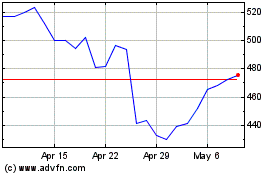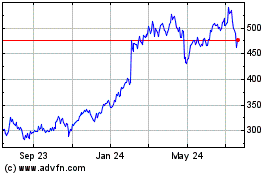By Mike Shields
In May, the do-it-yourself, home-and-garden site Hometalk made
its first big push into video on Facebook.
Since then, its Facebook video audience has surged, driven by
clips such as an eco-friendly oven cleaning technique that has
garnered over 38 million views since July 2, according to
Hometalk's co-founder and chief marketing officer, Miriam
Illions.
That's far more attention than Hometalk's videos have generated
on YouTube, where it has had a limited presence for years.
"Facebook is so instant," Ms. Illions said, because of the
inherent sharing that is part of the social network, helping videos
reach more people.
Hometalk's audience has been "nothing to write home about on
YouTube," she said. With the Google-owned video site, "it's painful
to know that these videos are sitting there" without the same level
of promotion.
While a relatively small brand like Hometalk may not represent
the entire web publishing world, Ms. Illions is not alone. Even as
the media business becomes more fixated on web video, some
publishers are questioning whether YouTube is still worth their
investment.
"You never count Google out, but something has to change at
YouTube, or Facebook and Snapchat are going to own this world,"
said a prominent digital media executive. For some newer media
companies, YouTube has become an afterthought, this person said.
"Google can't rest on its laurels."
The shift in tone regarding YouTube shows how quickly the
technology and media landscape as well as consumer habits have
evolved. YouTube, founded in 2005, reaches 1 billion people a
month, and the platform has built a sizable, mature ad business
that shares revenue with creators. Yet the video site is now
crowded with more content than ever, and it doesn't have the
built-in network for sharing that helps other sites rapidly amass
viewers, particularly on mobile.
A fair number of publishing executives say they are now more
bullish on platforms like Facebook, Instagram, Snapchat and, in
some cases, even Twitter when it comes to amassing video
audiences.
"A lot of media organizations have struggled on YouTube," said
Josh Topolsky, the former head of digital at Bloomberg who
previously helped launch The Verge. "They wish it was more of a
social network."
There are several examples of companies with large Facebook and
Instagram video audiences that have generated only modest
viewership on YouTube. The short-form video startup NowThis has
over 6.7 million fans on Facebook, where its videos generate
thousands, if not tens of thousands of views. On YouTube, NowThis
has just under 17,000 subscribers and its videos sometimes struggle
to crack a thousand views. Similarly, the Daily Mail's videos on
Facebook attract hundreds of thousands of views, but barely
register on YouTube.
Mr. Topolsky and other executives noted that, for many people,
YouTube often serves as a video search engine and not a place where
people connect with friends, limiting its ability to help users
discover new videos and have them spread.
To be sure, YouTube has fostered an ecosystem of homegrown
creators who do continue to thrive on the platform. These YouTube
stars have established their own form of video content, driven by
personalities, often talking to their fans directly about topics
ranging from videogames to beauty or hair tips. Given their fans'
propensity to subscribe to YouTube channels and to comment and
share, they likely very much see YouTube as a kind of social
network.
But, as many executives noted, media companies don't generally
excel at creating this type of personality-driven content, and
young people don't necessarily turn to YouTube seeking
professionally produced videos from big media brands.
According to Scott Grimes, co-founder and non-executive chairman
of the young male-oriented web company Woven Digital, publishers
need help standing out amidst the sea of YouTube stars. But YouTube
doesn't make it easy for content to get discovered or shared -- key
strengths of other social platforms like Facebook and Instagram, he
said.
"People underrate the shareability," Mr. Grimes said. "That's
really how you grow your audience as a publisher."
Mr. Grimes said that if he were starting a new media company
now, he'd focus on Facebook and less on YouTube, though his company
is not abandoning YouTube.
YouTube, for its part, says that more and more creators and
media companies are publishing on its platform and finding
audiences. "In the past year alone, we've launched thousands of
additional news channels to YouTube and the time people spent
watching news content has more than doubled. Our partner revenue
growth has averaged 50% over the last three years" said a YouTube
spokeswoman.
The Web video giant recently introduced a live mobile streaming
offering. Plus, it boasts of content distribution deals with media
giants like the NFL and has made strides in getting advertisers to
consider it as an alternative outlet for TV budgets.
There are companies like Vox Media creating original videos that
often exceed 4 million views on YouTube. Or take BuzzFeed. Even as
the company has rolled out 20 unique brands on Facebook, including
the food-oriented Tasty (which has a staggering 65 million fans on
Facebook), the media startup has continued to pour resources into
YouTube, where series like " The Try Guys" regularly garner
millions of views.
To its credit, YouTube has helped nurture newer media brands
such as the general interest WatchCut and the news-oriented Seeker
Daily, both of which have amassed more than 1 million subscribers
over the past few years, while attracting far fewer Facebook
fans.
Some publishers contend that while it's harder to gain
viewership on YouTube, the audience proves to be far more engaged
and loyal.
"On YouTube, once they are with you, they are with you," said
Steven Oh, chief business officer at the progressive-leaning web
video company The Young Turks.
It's worth noting that YouTube shares 55% of the revenue
generated by pre-roll ads with the publisher, while Facebook, for
instance, doesn't offer pre-roll video ads. But, at the same time,
Facebook has been paying media companies and celebrities directly
to create videos and experiment with its Facebook Live feature.
"There are no deals to be had at YouTube that are particularly
compelling," said Jon Steinberg, the former Daily Mail and BuzzFeed
executive who recently launched the business-oriented video brand
Cheddar with a big focus on Facebook Live. "There is no discovery,
and there are nickel-and-dimey [ad rates]."
The power of Facebook's vast network -- not to mention the fact
that videos play automatically on the site and that Facebook's
algorithm appears to favor video -- is hard for publishers to
resist.
"We see YouTube as a valuable place," said Micah Gelman, senior
editor and director of editorial video at the Washington Post. "But
the pure audience on Facebook is so much bigger."
Write to Mike Shields at mike.shields@wsj.com
(END) Dow Jones Newswires
July 21, 2016 06:14 ET (10:14 GMT)
Copyright (c) 2016 Dow Jones & Company, Inc.
Meta Platforms (NASDAQ:META)
Historical Stock Chart
From Mar 2024 to Apr 2024

Meta Platforms (NASDAQ:META)
Historical Stock Chart
From Apr 2023 to Apr 2024
